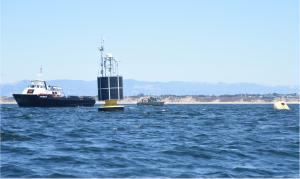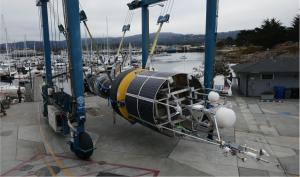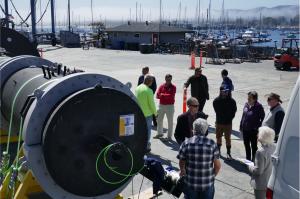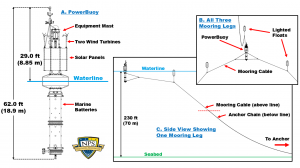First-of-its-Kind, Self-Powered Ocean Buoy to Enhance NPS Research and 5G Maritime Communication Applications

Naval Postgraduate School (NPS) deployed an Ocean Power Technologies self-powered buoy for oceanographic and meteorological studies and 24/7 maritime domain awareness applications.

As a maritime domain awareness technology demonstrator, the self-powered Ocean Power Technologies (OPT) PowerBuoy will enable research into real-time tracking of vessels on and under the ocean relaying data via its AT&T 5G maritime base station.

The Naval Postgraduate School (NPS) Ocean Sensing Buoy project provides a platform to support collaborative research with NPS focused on studies of Monterey Bay throughout the scientific community.
The prototype PowerBuoy provides 24/7 maritime domain awareness and METOC data relayed real-time to Naval Postgraduate School (NPS) via AT&T 5G technologies.
MONTEREY, CA, UNITED STATES, July 11, 2025 /EINPresswire.com/ -- Floating in Monterey Bay, California, five miles north of the Naval Postgraduate School (NPS) campus, a self-powered ocean buoy will showcase a unique combination of oceanographic and meteorological sensors with 5G communication technologies for real-time, 24/7 scientific and maritime observations.
Developed in collaboration with Ocean Power Technologies (OPT) and AT&T, the NPS buoy research project will demonstrate a host of undersea, surface and atmospheric sensors with a 5G maritime base station and data relay. Extending 5G connectivity beyond the reach of traditional coastal networks also promises in the future to bring the benefits of high-speed data to mariners limited by cellular, VHF radio and more expensive satellite communication.
The NPS project utilizes an OPT PowerBuoy as a technology demonstrator with various sensors powered by solar and wind. The buoy is certified safe for use in the Monterey Bay, including environmental and marine sanctuary requirements, and is securely anchored with three moorings to ensure stability and near-line-of-sight communication with the NPS campus.
“This ocean buoy project is part of an overall effort to increase our maritime sensing and experimentation capabilities right here in Monterey,” said Kevin Smith, the principal investigator who is an acoustics researcher and chair of the physics department at NPS. “And it provides an opportunity for collaborative ocean research throughout the Monterey Bay community.”
Monterey Bay is home to a wealth of important scientific institutions and marine laboratories, which are invited to utilize the data collected by the buoy for collaborative research. NPS has existing partnerships and collaborations with the U.S. Coast Guard, National Oceanic and Atmospheric Administration (NOAA), U.S. Naval Research Lab, Stanford Doerr School of Sustainability, Monterey Bay Aquarium Research Institute, and the Western Flyer, a historic vessel once used by John Steinbeck and Ed Ricketts for marine science re-equipped with current meteorology instrumentation in collaboration with NPS for STEM education at sea. Stanford’s Hopkins Marine Station has already installed a passive acoustic receiver on the buoy for detecting great white sharks carrying acoustic tags as well as other species in Monterey Bay.
Oceanographic and meteorological data continuously collected by the NPS sensors on the buoy will be available for use by other researchers and academic institutions in the area that study the Monterey Bay, such as the University of California at Santa Cruz, San Jose State University, and Cal State Monterey Bay, which recently signed an educational partnership agreement with NPS.
“The buoy project provides a new persistent capability for real-time sensing and networking with the shore and with autonomous systems above, on, and below the water’s surface,” Smith added. “So, it supports science as well as applied research in naval operations and maritime domain awareness needs of the U.S. Navy.”
Study of the sea in support of naval warfighting has always been a focus of NPS to ensure maritime advantage in any climate and in all weather. Understanding and accurately predicting operational environments remains critical to effective force planning, readiness, and warfighter resilience that NPS enables as a center of academic excellence for the U.S. Navy and DOD.
“Our PowerBuoy allows true multi-domain flexibility from seabed to space,” said OPT’s CEO Philipp Stratmann. “We have deployed PowerBuoys around the globe, and this one will be leased to NPS. PowerBuoys give the ability to deploy sensors, collect data, and do things in the ocean that wouldn’t be possible otherwise. They can open huge parts of our world’s oceans to operations for persistent and resident data collection that meets maritime security and protection needs.”
OPT integrated its Maritime Domain Awareness Solution (MDAS) into the NPS buoy research project, enabling it to autonomously monitor surface vessel activity. It has a transponder for the Automated Identification System (AIS)—the common tracking system used by a ship to communicate its identification, location, heading, speed, and other details over VHF radio signals. MDAS also has a surface search radar and a high-definition infrared camera that can detect ships and boats that aren’t operating with AIS.
Stratmann added, “For marine protected areas, our PowerBuoys networked together could detect who's entering and operating in them. This allows improved enforcement and prosecution when violations occur. From a Navy perspective, it’s trying to keep bad actors out of certain locations in the ocean. Now it has the means to monitor these locations on a permanent basis.”
With power generation optimized for Monterey Bay’s location, the OPT PowerBuoy’s solar panels and wind turbines charge high-capacity, safe marine batteries that store enough electrical energy to make its operations completely self-sufficient. The marine battery composition is also more chemically and thermally stable than what’s found inside the common lithium-based batteries powering personal electronics.
5G at Sea:
5G maritime base stations bring promise to revolutionize naval and commercial shipping, as 5G has done ashore. Costing far less than satellite data usage, 5G base stations at sea can provide internet access, high-speed data transmission, and communication capabilities to vessels operating further from shore than existing 4G or Wi-Fi networks can reach. Future 5G maritime networks can utilize a "multi-hop" concept where signals are passed from buoy base stations, one ship to another, and to shore with a data link enabling real-time access to ship systems, weather and navigational updates, and more efficient operations through remote control and automation.
“5G is especially important in maritime environments where more and more ships and unmanned vehicles are working together,” said AT&T program manager retired U.S. Navy Cmdr. Robby Schimelpfening, also an NPS alumnus of the space systems operations curriculum. “We think that 5G technology certainly has a place to play in the command-and-control structure that the industry and Navy is looking to deploy in the future.”
While promising, 5G at sea research needs to solve challenges related to signal propagation, harsh environmental conditions, and the need for robust and reliable infrastructure in the littorals.
In 2021, NPS and AT&T signed a Cooperative Research and Development Agreement (CRADA) for 5G at sea research, and will use a Limited Purpose CRADA with NPS for this buoy project.
“Installed on top of the OPT PowerBuoy is the first AT&T 5G maritime base station ever put at sea,” added Schimelpfening. “There’s great utility in having 5G communications capabilities for both tactical users, like NPS, and typical commercial users.”
The buoy’s 5G signal range is limited to about a half-mile radius, but mariners within this bubble can make 5G calls, which are relayed through directional microwave antennae between the buoy and NPS, a system commonly used to provide broadband access. While the buoy’s three-point mooring system keeps it secure and aligned for connectivity, AT&T’s system can make active adjustments to the signal beam to compensate for small movements by the buoy, as well.
To give the buoy flexible communication options, the project also includes broadband satellite access using Starlink. The ability to switch between communication networks supports Navy research in network robustness and resilience, aspects critical to operations in remote maritime environments.
Maritime Sensing:
For the initial effort, researchers from the NPS oceanography department added sensors to track current throughout the water column, conductivity to measure salinity, and water temperature at different positions up and down the buoy. Onboard sensors and future instruments to be added by the NPS meteorology department will measure a variety of atmospheric data points. NPS Faculty Associate Ryan Yamaguchi is the lead for the meteorology portion of the project.
“The general lack of data over the maritime environment prevents improving the accuracy of weather and ocean modelling, essential for naval operations, especially at the air-sea interface," said Yamaguchi. "It is critical to sample the near-surface processes with high-fidelity, in-situ measurement systems, which the OPT buoy platform will allow researchers to sample. Over the life of the project, various sensors can be employed and this data will provide not only deeper insight into the complex science of the atmosphere and ocean system but can also investigate Navy relevant applications such as propagation effects of acoustics in the water and electromagnetics in the air.”
All these sensors collect important data needed for improving prediction models such as NEPTUNE, the Navy’s new weather forecasting model.
“There's a lot of complexity in numerically modeling how the atmosphere couples to the ocean,” said Professor Emeritus Tim Stanton, a buoy expert in NPS’ oceanography department. “This project takes advantage of the large power source available on the buoy and its very high bandwidth 5G data communications back to NPS. The buoy will give us an opportunity to better understand some of the processes that are difficult to capture in the current Navy models."
Long-term, high-resolution measurements of ocean currents from the surface to the seafloor help scientists understand how wind at the surface transfers energy into the ocean. This energy moves through the upper mixed layer—about 50 feet deep—and into deeper water.
Stanton added, "Below the mixed layer, differences in water density support strong, slow-moving, tidal-forced, internal waves that come in from the edge of the continental shelf. These long-term observations help researchers study the various forces that drive ocean currents, which in turn improves the accuracy of the Navy’s high-resolution ocean-atmosphere models."
Equipped with a subsea umbilical connector, the buoy’s future capability extends below the surface of the water where it can connect with undersea sensors and systems. For example, the NPS physics, oceanography, and mechanical engineering departments all have ongoing research into underwater acoustics and communication networks for potential submarine and autonomous underwater vehicle research.
To deploy the buoy in the Monterey Bay, NPS worked with local, state and federal agencies to ensure requirements for safety and environmental considerations were met, including NOAA Office of National Marine Sanctuaries (permit MBNMS-2024-005); California State Lands and Coastal Commissions; Long Beach Office Branch Chief, Protected Resources Division, for the West Coast region, National Marine Fisheries Service; and the Naval Region Southwest, Fleet Environmental Coordinator.
“It takes a great deal of effort and cooperation to do this right,” said Smith who credits Mike Richardson, director of NPS’ Joint Interagency Field Experimentation (JIFX), for spearheading the buoy integration and deployment. “I’d like to thank the many people involved who, over the years, made this buoy project possible, and we look forward to the discoveries ahead with our students, faculty, and research partners.”
(Participating organizations mentioned does not constitute endorsement for their products or services by the Naval Postgraduate School, the Department of the Navy, or the Department of Defense.)
Established in 1909, Naval Postgraduate School (NPS) provides defense-focused graduate education, including classified studies and interdisciplinary research, to advance the operational effectiveness, technological leadership and warfighting advantage of the Naval service. Located in Monterey, California, NPS offers master’s and doctoral programs for U.S. military and civilians, federal agencies, allied militaries and partner nations.
LCDR Kristina Wiedemann, USN
Naval Postgraduate School, Public Affairs
+1 831-656-3567
pao@nps.edu
Visit us on social media:
LinkedIn
Instagram
Facebook
YouTube
X
Legal Disclaimer:
EIN Presswire provides this news content "as is" without warranty of any kind. We do not accept any responsibility or liability for the accuracy, content, images, videos, licenses, completeness, legality, or reliability of the information contained in this article. If you have any complaints or copyright issues related to this article, kindly contact the author above.


